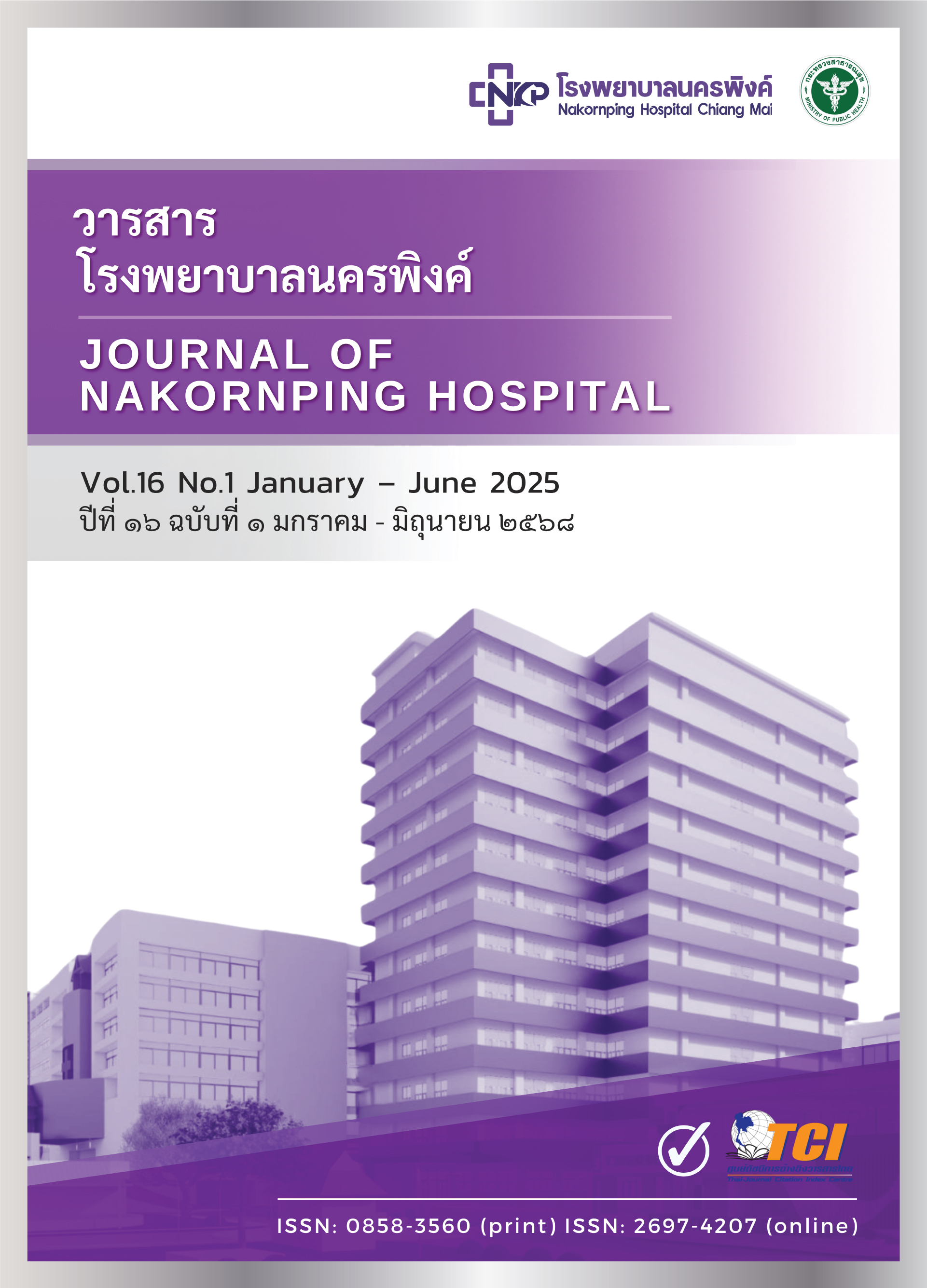The situation of detecting COVID-19 virus variants and clinical symptoms of infected patients at Nakornping Hospital, Chiang Mai during 2021–2023
Keywords:
Coronavirus 2019, COVID-19 virus strain, severe symptoms, mutationAbstract
Background: Coronavirus disease 2019, caused by the SARS-CoV-2 virus, has a variable incubation period and severity of infection, depending on the virus's mutations. Infected individuals may experience no symptoms or only mild symptoms, while others may develop severe symptoms, potentially leading to death.
Objective: This study aimed to investigate the SARS-CoV-2 strains, trends in clinical symptoms, and severity levels among individuals infected with various strains circulating in Chiang Mai Province.
Method: A retrospective analysis of medical records, laboratory databases, and information systems for 357 COVID-19 patients with confirmed variant identification and documented symptom histories at Nakornping Hospital from June 2021 to August 2023.
Results: The Alpha variant of COVID-19 was detected before June 2021 and disappeared by November 2021. The Delta variant emerged in June 2021 and disappeared by May 2022. The Omicron variant was first detected in December 2021 and remains present to date. When analyzing symptoms, the five most common symptoms among infected individuals were fever (45%), cough (43%), sore throat (33%), headache (18%), and runny nose (18%). Patients infected with the Omicron variant exhibited more severe symptoms compared to those with the Alpha and Delta variants, with mortality rates of 26.8%, 9%, and 9%, respectively. Additionally, the Omicron variant has undergone mutations resulting in subvariants with varying severity based on mutation sites. The BA.2 subvariant was particularly severe, with a high mortality rate of 34%. Over time, the Omicron variant continued to mutate, especially in the latter part of 2023, during which the number of COVID-19 infections detected decreased.
Conclusion: Alpha, Delta, and Omicron strains were identified as spreading in Chiang Mai province. Most infected individuals experienced symptoms such as fever, cough, headache, runny nose, and sore throat. The BA.2 substrains of Omicron were associated with a higher risk of death compared to other strains.
References
Shi Y, Wang G, Cai XP, Deng JW, Zheng L, Zhu HH, et al. An overview of COVID-19. J Zhejiang Univ Sci B. 2020;21(5):343-60. doi: 10.1631/jzus.B2000083.
Chittaganpitch M. Coronavirus Disease 2019; COVID-2019. [Internet]. Nonthaburi: Department of Medical Sciences; c2019 [updated 2020 Oct 16; cited 2023 Dec 30]. Available from: https://nih.dmsc.moph.go.th/data/data/64/covid/covid_lab16102020.pdf [In Thai]
Khateeb J, Li Y, Zhang H. Emerging SARS-CoV-2 variants of concern and potential intervention approaches. Crit Care. 2021;25(1):244. doi: 10.1186/s13054-021-03662-x.
Tian D, Sun Y, Xu H, Ye Q. The emergence and epidemic characteristics of the highly mutated SARS-CoV-2 Omicron variant. J Med Virol. 2022;94(6):2376-83. doi: 10.1002/jmv.27643.
Di H, Pusch EA, Jones J, Kovacs NA, Hassell N, Sheth M, et al. Antigenic Characterization of Circulating and Emerging SARS-CoV-2 Variants in the U.S. throughout the Delta to Omicron Waves. Vaccines. 2024;12(5):505. doi: 10.3390/vaccines12050505.
Guo H, Ha S, Botten JW, Xu K, Zhang N, An Z, et al. SARS-CoV-2 Omicron: Viral Evolution, Immune Evasion, and Alternative Durable Therapeutic Strategies. Viruses. 2024;16(5):697. doi: 10.3390/v16050697.
World Health Organization. Coronavirus disease (COVID-19) [Internet]. Switzerland: World Health Organization; c2021 [updated 2023 Mar 28; cited 2023 Dec 24]. Available from : https://www.who.int/emergencies/diseases/novel-coronavirus-2019/question-and-answers-hub/q-a-detail/coronavirus-disease-covid-19.
Sila T, Laochareonsuk W, Surachart K, Surasombatpattana S, Saelim W, Sangkhathat S. Evolution and bioinformatic analysis of the whole genome sequences of SARs-COV-2. PSU Medical Journal. 2022;2(2):85-98. doi: 10.31584/psumj.2022254705 [In Thai]
World Health Organization. Enhancing response to Omicron SARS- CoV- 2 variant [Internet]. Switzerland: World Health Organization; c2021; [updated 2022 Jan 21; cited 2024 Feb 17]. Available from: https://cdn.who.int/media/docs/default-source/searo/thailand/enhancing-readiness-for-omicron_thai_20211201.pdf?sfvrsn=1b702261_5
Chailek C. Why did BA.2 spread faster than the original omicron strain [Internet]. Bangkok: The Standard; c2022 [updated 2022 Feb 18; cited 2024 Feb 17]. Available from: https://thestandard.co/why-ba-2-is-faster-spreading-than-omicron/ [In Thai]
Hfocus. Deep to the health system. watch! "BA.4 -BA.5" surges in Thailand, more than 200 cases found [Internet]. Bangkok: Hfocus; c2022 [updated 2022 Jun 24; cited 2024 Feb 24]. Available from: https://www.hfocus.org/content/2022/06/25370 [In Thai]
Hfocus. Update! The Department of Medical Science reveals that COVID BA.2.75 is currently the main strain circulating in Thailand. [Internet]. Bangkok: Hfocus; c2022 [updated 2022 Dec 7; cited 2024 Feb 25]. Available from: https://www.hfocus.org/content/2022/12/26560 [In Thai]
Roemer C, Hisner R, Frohberg N, Sakaguchi H, Gueli F, Peacock TP. SARS-CoV-2 evolution, post-Omicron [Internet]. UK: Virological; c2022 [updated 2023 Aug; cited 2024 Feb 25]. Available from: https://virological.org/t/sars-cov-2-evolution-post-omicron/911
Alimohamadi Y, Sepandi M, Taghdir M, Hosamirudsari H. Determine the most common clinical symptoms in COVID-19 patients: a systematic review and meta-analysis. J Prev Med Hyg. 2020;61(3):E304-12. doi: 10.15167/2421-4248/jpmh2020.61.3.1530.
Takheaw N, Liwsrisakun C, Laopajon W, Pata S, Chaiwong W, Inchai J, et al. Levels and durability of neutralizing antibodies against SARS-CoV-2 Omicron and other variants after ChAdOx-1 or BNT162b2 booster in CoronaVac-primed elderly individuals. Heliyon. 2023;9(4):e15653. doi: 10.1016/j.heliyon.2023.e15653.
Liwsrisakun C, Pata S, Laopajon W, Takheaw N, Chaiwong W, Inchai J, et al. Neutralizing antibody and T cell responses against SARS-CoV-2 variants of concern following ChAdOx-1 or BNT162b2 boosting in the elderly previously immunized with CoronaVac vaccine. Immun Ageing. 2022;19(1):24. doi: 10.1186/s12979-022-00279-8.
Department of Disease Control. Guideline to collecting and sending samples to detect SARS-CoV-2 strains by Whole genome sequencing method [Internet]. Nonthaburi: Department of Disease Control; c2021 [updated 2021 Nov 24; cited 2024 Feb 25]. Available from: https://ddc.moph.go.th/viralpneumonia/file/g_srrt/g_srrt_manual_wgs_271164.pdf [In Thai]
Downloads
Published
How to Cite
Issue
Section
License
Copyright (c) 2025 Nakornping Hospital

This work is licensed under a Creative Commons Attribution-NonCommercial-NoDerivatives 4.0 International License.
The articles that had been published in the journal is copyright of Journal of Nakornping hospital, Chiang Mai.
Contents and comments in the articles in Journal of Nakornping hospital are at owner’s responsibilities that editor team may not totally agree with.


